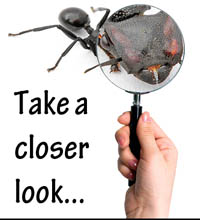Ant Anatomy and Biology
Size information
Ants, like all insects, have jointed legs, three body parts (the head, thorax and abdomen), a pair of antennae, and a hard exoskeleton. The exoskeleton is made up of a material that is very similar to our fingernails. Ants range in color from yellow to brown to red to black.
Some ants have a stinger and some can even inject poisonous acid from the stinger (the stinger is at the tip of the abdomen, the rear body segment). Ants can also bite using their jaws (mandibles). Ants range in size from about 0.08 inch (2 mm) to up to about 1 inch (25 mm) long.
Unique Physical
Abdomen - The abdomen is the segmented tail area of an ant. It contains the heart,Malpighian tubules, reproductive organs, and most of the digestive system (foregut, hindgut and rectum). It is protected by an exoskeleton.
Antennae - Ants have two jointed antennae. They are sensory appendages attached to the head.
Compound eye - Ants have two compound eyes. These eyes are made up of many hexagonal lens/corneas which focus light from each part of the insect's field of view onto a rhabdome (the equivalent of our retina).
Head - The head of an ant (or any insect) is the location of its brain, two compound eyes, its proboscis, pharynx (the start of the digestive system), the point of attachment of its two antennae, etc.
Jointed Leg - Ants, like all insects, have six jointed legs.
Mandibles - Mandibles are the jaws of the ant. The mandibles bite off food and tear it into small, easily digestible pieces.
Thorax - The thorax is the chest area of an insect (including ants). The thorax is divided into three segments; on each segment is a pair of legs. The thorax contains the muscles that make the legs move.
How Ant Breathe
Ants, like all insects, don’t have lungs, breathing through tiny holes in their sides – spiracles – one pair per segment. These lead into a network of tiny tubes – tracheae – permeating their entire body, getting narrower and narrower, supplying air (and hence oxygen), right to the tissues that use it, rather than using blood to transport it like us. Though they can open and close their spiracles, they have little ability to pump air in and out, which happens just through general movement. It’s this inability that stops insects getting as big as us, with our ultra-efficient lungs and blood.
Life Cycles
The average lifespan of a worker ant is about 6 months
the average lifespan of a queen is 3 years....
The life span of the ant varies from caste to caste, and species to species. The workers of some species live only for a few weeks, where other ants may live for a few years....... The queen of the tiny 'Pharaoh ant, may live for only three months, but the queen of black garden ant can live for up to 15 years or so!!!! The record for ant longevity is held by a black garden ant queeen who, in a German laboratory nest, lived for 29 years

No comments:
Post a Comment